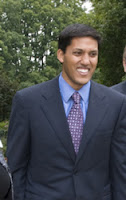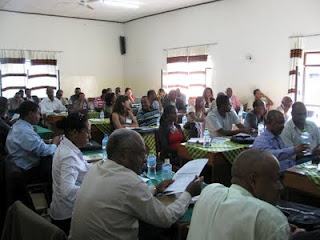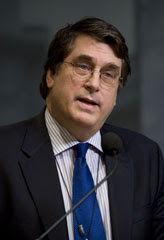-
Amid Blizzards, Protests, and Lock-downs, Population Gets Stunning Moments in the Sun in Copenhagen
›The second week of negotiations here in Copenhagen has been marked by dramatic events, as the deadline for a new global agreement to address climate change approaches.
Blocs of negotiators from developing countries have walked out, and returned. Thousands of NGO representatives who have been denied access to the proceedings are shivering in the cold. Observers inside the Bella Center have staged sit-ins. And yet slivers of hope remain for some form of a global deal that is fair, ambitious, and binding as negotiators prepare for the arrival of more than 100 heads of state on Friday.
-
Development Seeking its Place Among the Three “Ds”
›December 15, 2009 // By Dan Asin“By one count, there are now over 140 goals and priorities for U.S. foreign assistance,” Senator John Kerry said during the nomination hearing for USAID Administrator-designate Rajiv Shah. If Shah is confirmed, his principal tasks will be moving development out from the shadow of defense and diplomacy and bringing definition to USAID’s mission.
“USAID needs to have a strong capacity to develop and place and deploy our civilian expertise in national security areas,” Shah said at his nomination hearing. USAID “has a responsibility to step up and offer very clear, visible, and understood strategic leadership,” as well as clarify “the goals and objectives of resources that are more oriented around stability goals than long-term development goals.”
A difficult task—and whether Shah wants it or not, he’ll get plenty of help from State, the Obama Administration, and Congress.
State Department Reviews Diplomacy and Development
The State Department’s Quadrennial Diplomacy and Development Review (QDDR)—launched in July by Shah’s impending boss, Secretary of State Hilary Clinton—will certainly inform his USAID vision. Modeled after the Defense Department’s Quadrennial Defense Review (QDR), the QDDR is designed to enhance coordination between USAID and State.
Anne-Marie Slaughter, director of policy planning at the State Department and co-leader of the review process, laid out the QDDR’s specific goals at a recent event hosted by the Center for American Progress:- Greater capacity for, and emphasis on, developing bilateral relationships with emerging nations, working within multilateral institutions, and working with non-state actors
- Capability to lead “whole-of-government” solutions to international challenges
- More effective coordination between top-down (diplomatic) and bottom-up (development) strategies for strengthening societies
- Greater capacity to launch on-the-ground civilian responses to prevent and respond to crises
- Flexible human resource policies regarding the hiring and deployment of contractors, foreign service officers, and development professionals
Obama Administration, Congress Also Join In
Details on the Presidential Study Directive (PSD) on Global Development Policy—outside its broad mandate for a government-wide review of U.S. development policy—are similarly sparse. The directive’s fuzzy parameters leave open the potential for its intrusion into the QDDR’s stated objectives.
But from what little is available, both the QDDR and PSD appear to be part of complementary efforts by the Obama administration to elevate development’s role in U.S. foreign policy, using whole-of-government approaches.
Lest Congress be left out, each chamber is working on its own development legislation. Senators John Kerry and Richard Lugar’s Foreign Assistance Revitalization and Accountability Act of 2009 (S. 1524) seeks “to strengthen the capacity, transparency, and accountability of United States foreign assistance programs to effectively adapt and respond to new challenges.” The act would reinforce USAID by naming a new Assistant Administrator for Policy and Strategic Planning, granting it greater oversight over global U.S. government assistance efforts, and strengthening its control over hiring and other human resource systems.
Congressmen Howard Berman and Mark Kirk’s Initiating Foreign Assistance Reform Act of 2009 (H.R.2139) would require the president to create and implement a comprehensive global development strategy and bring greater monitoring and transparency to U.S. foreign assistance programs.
Successful legislation in the Senate and House could pave the way for the reformulation of the Foreign Assistance Act of 1961, whose message has been rendered complicated and sometimes contradictory by decades of amendments.
And all these ambitious efforts are complicated by the involvement of 25 independent government agencies in U.S. foreign assistance—a formidable challenge to any administrator.
Photo: Courtesy of the USDA. -
Nobel Pursuits: Linking Climate Efforts With Development, Natural Resources, and Stability
›December 11, 2009 // By Geoffrey D. DabelkoThe only mention of climate change in President Obama’s Nobel Peace Prize acceptance speech falls squarely in the climate and security context. He introduces the climate imperative by highlighting natural resources and development connections to stability and human well-being.
In these two paragraphs, the President identifies the key communities that must come together, first in dialogue and then in cooperation, but who so commonly don’t: development, natural resources, health, climate, peacebuilding, and security.It is undoubtedly true that development rarely takes root without security; it is also true that security does not exist where human beings do not have access to enough food, or clean water, or the medicine and shelter they need to survive. It does not exist where children can’t aspire to a decent education or a job that supports a family. The absence of hope can rot a society from within.
Photo: President Barack Obama looks at the Nobel Peace Prize medal at the Norwegian Nobel Institute in Oslo, Norway, Dec. 10, 2009 (Official White House Photo by Pete Souza).
And that’s why helping farmers feed their own people — or nations educate their children and care for the sick — is not mere charity. It’s also why the world must come together to confront climate change. There is little scientific dispute that if we do nothing, we will face more drought, more famine, more mass displacement — all of which will fuel more conflict for decades. For this reason, it is not merely scientists and environmental activists who call for swift and forceful action — it’s military leaders in my own country and others who understand our common security hangs in the balance. -
VIDEO – Integrating Population, Health, and Environment (PHE) in Ethiopia
›December 4, 2009 // By Sean Peoples“Incorporating environment, population, and health is a timely issue. Unless we focus on integrated approaches, our Ethiopian Millennium Development Goals cannot be achieved,” says Negash Teklu, executive director of the Consortium for Integration of Population, Health, and Environment (CIPHE), in this short video.
I interviewed Teklu and three other members of CIPHE in Yirgalem, Ethiopia, where they spoke of the importance of PHE integration; why it is vital to involve the community in development projects; and practical steps for implementing integration at the grassroots level.
Everyone agrees that Ethiopia faces serious challenges. Much of the economy is based on agriculture, but drought is all too common, and the land is exacerbated by continual overuse. High rates of population growth coupled with limited resources and uncertain crop yields leaves many people vulnerable to hunger and malnutrition. In addition, the country’s health system struggles to provide comprehensive care.
To combat these interconnected problems, the members of CIPHE truly believe that an integrated PHE approach that uses multi-sectoral interventions will best serve the needs of their fellow Ethiopians.
“If we follow the integrated PHE approach, economically we can be beneficial,” Mogues Worku of LEM Ethiopia told me. “We can share a lot of resources among the different sectoral organizations. At the same time with limited resources we can attain our goal by integrating the different sectoral offices and organizations, even at the grassroots level.”
This video will be the first of many on population, health, and environment problems and solutions in Ethiopia. Subscribe to our ECSP YouTube channel or the New Security Beat blog to see the latest videos. -
Ethiopia: A Holistic Approach to Community Development Blossoms Two Years After Taking Root
›November 12, 2009 // By Sean Peoples As evening fell upon Yirgalem, Ethiopia, more than 70 participants from a large cross-section of Ethiopia’s NGO community—as well as a few international participants like myself—gathered in a packed conference room in the Furra Institute for the second annual General Assembly of the Consortium for the Integration of Population, Health, and Environment (CIPHE).
As evening fell upon Yirgalem, Ethiopia, more than 70 participants from a large cross-section of Ethiopia’s NGO community—as well as a few international participants like myself—gathered in a packed conference room in the Furra Institute for the second annual General Assembly of the Consortium for the Integration of Population, Health, and Environment (CIPHE). -
The Future of Family Planning Funding
›November 3, 2009 // By Kayly Ober“Family planning is one of the biggest success stories of development cooperation,” said Bert Koenders, Dutch Minister for Development Cooperation, via video at a Wilson Center roundtable discussion on the future of family planning funding. Koenders was followed by representatives of three of the field’s largest donors, Musimbi Kanyoro, director of the David and Lucile Packard Foundation’s Population and Reproductive Health Program; José “Oying” Rimon, senior program officer for Global Health Policy and Advocacy at the Bill and Melinda Gates Foundation; and Scott Radloff, director of USAID’s Office of Population and Reproductive Health.
Celebrating Family Planning Success Radloff said his organization has “success stories in every region of the world.” USAID’s family planning and reproductive health programs have shown positive gains over the last few years, especially in Latin America where “most countries have graduated from bilateral assistance or are in the process of graduating,” he added.
Radloff said his organization has “success stories in every region of the world.” USAID’s family planning and reproductive health programs have shown positive gains over the last few years, especially in Latin America where “most countries have graduated from bilateral assistance or are in the process of graduating,” he added.
Rimon lauded the strides made within developing societies where contraceptive use has become the norm. Since the 1960s, the contraceptive prevalence rate in developing countries has increased from ten per cent to about 55 per cent; which, in turn, has prompted the total fertility rate to fall from fall from six children to about three in the same time frame, he said.
Rimon was even more hopeful about the future of the field, as he claimed that “the decline for family planning/reproductive health resources, which has been happening since the mid 1990s, has been reversed.” Since 2006, the amount of resources allocated to family planning has steadily risen.
Facing Current Challenges
While funding for family planning has been gaining momentum in recent years, it still faces enormous obstacles. “The biggest challenge,” said Koenders, is investing in youth—more than half the world’s population. “We should acknowledge the needs and rights of adolescents and young people—married and unmarried—in the field of sexual and reproductive health,” he said.
Koenders also stressed the need to find common strategies to “counterbalance…growing opposition to sexual and reproductive health and rights,” as it is “not only about abortion.” The reproductive rights of women and girls are “closely linked to the deeply rooted imbalance in power relations between women and men, and the increasing sexual violence against women.”
Nowhere is this challenge more acutely observed than in “the poorest countries of the world, in Africa and South Asia,” said Radloff. If “you look across the countries of Africa, the countries that are lagging behind in terms of increasing contraceptive use and availability of contraceptives, it’s largely Francophone West Africa.”
By 2050, Africa’s population is projected to double. “India would be around 1.7 billion and stabilizing. China would be around 1.5 billion stabilized. And Africa would be at two billion and still growing, in some of the most fragile countries which have very serious economic and development issues,” said Rimon.
Kanyoro said the Packard Foundation will “take a good look at what is happening in sub-Saharan Africa so that we can be able to address some of those areas that are the weakest in the link.” The foundation’s plans include high-level advocacy “to make sure that these messages go across not just one country but several countries and even, if possible, benefit from inter-regional work.”
Opportunities in the Obama Era “I’m an optimist,” said Rimon, who sees opportunities amid these myriad challenges. Not only has the long decline in funding being reversed, but there is a “major trend towards more effective and better policies, and I think here in the U.S. we have seen that: rescission of the Mexico City policy, the new guidelines in PEPFAR, and some with the new changes and policies that are also seen in Europe.”
“I’m an optimist,” said Rimon, who sees opportunities amid these myriad challenges. Not only has the long decline in funding being reversed, but there is a “major trend towards more effective and better policies, and I think here in the U.S. we have seen that: rescission of the Mexico City policy, the new guidelines in PEPFAR, and some with the new changes and policies that are also seen in Europe.”
Radloff agreed that USAID has seen “positive engagement of the administration on reaffirming U.S. support for the MDGs, including MDG 5b and improving access to reproductive health information and services and reaffirming support for the ICPD [International Conference on Population and Development] program of action.” He also found it encouraging that “many bilateral donors, multilateral donors, and foundations are now very interested in working closely with USAID in advancing these programs…the environment, in general, is much better than it’s been at least since 1992, and perhaps even ever.”
“We have, in addition to having strong support in our administration, both a president and a secretary of state that speak out passionately about the need to reduce unintended pregnancies and to make family planning more widely available,” Radloff continued.
“We have family planning and reproductive health included as a priority under the Global Health Initiative which was announced by the President back in May. That initiative encompasses family planning, reproductive health, maternal-child health, and various infectious diseases, including HIV, TB, and malaria. The fact that he placed these under a single initiative, rather than creating two new initiatives for family planning and maternal-child health signals his interest in ensuring that we integrate these programs to the extent practical.”
Sustaining Progress Over the Long Term “I come from Africa, and I know that we can literally grow anything. We can have every small project. But the really big difference is when those problems are brought to big scale,” said Kanyoro. Developing the capacity of local leaders—particularly women—is necessary to make sustainable gains in the field, she said, as well as collaboration between government donors and private funders to drive innovation. “I think private money is really good for paving the way, but I think that private money and government money [are] really what makes the biggest difference in scale.”
“I come from Africa, and I know that we can literally grow anything. We can have every small project. But the really big difference is when those problems are brought to big scale,” said Kanyoro. Developing the capacity of local leaders—particularly women—is necessary to make sustainable gains in the field, she said, as well as collaboration between government donors and private funders to drive innovation. “I think private money is really good for paving the way, but I think that private money and government money [are] really what makes the biggest difference in scale.”
Radloff agreed that we should not view the sectors “as independent of each other, but interrelated.” Governments should partner with the private sector to “develop strategies that incorporate the contributions of private sector and public sector, and acts in ways that improves the environment for private sector investments and involvement,” he said. Such collaboration will lead to success: “Almost uniformly, where we graduate countries, is where there is a strong private sector providing services to those who can pay.” -
VIDEO: Scott Radloff on Family Planning Under the Obama Administration
›November 3, 2009 // By Wilson Center Staff“We have a new administration that places a priority on family planning and reproductive health,” Scott Radloff, director of the Office of Population and Reproductive Health at the U.S. Agency for International Development (USAID), tells ECSP Director Geoff Dabelko after a discussion on the future of family planning at the Woodrow Wilson Center.
The Obama administration has rescinded the Mexico City Policy and announced an expanded Global Health Initiative. Radloff credits these new policies with opening opportunities “to work with key organizations in international family planning.”
The new family planning and reproductive health programs will address the large unmet need for family planning services in the developing world, particularly in Africa and South Asia. New programs will focus on reaching people in rural communities far from health clinics. “We expect to have great success,” he said. -
Missives From Marrakech: Growing and Slowing, and a Letter From the King
›October 5, 2009 // By Gib Clarke Here in Morocco, where I am attending the IUSSP conference on population, if you never went to elementary school or if you married at a young age, you are likely to have more children.
Here in Morocco, where I am attending the IUSSP conference on population, if you never went to elementary school or if you married at a young age, you are likely to have more children.
A Bangladeshi couple is more likely to have a third child if they have 0-1 sons, but a European couple is increasingly likely to prefer daughters because they take better care of their aging parents.
Globally, a forthcoming Harvard study shows that the “Reproductive Health Laws Index”—which includes the legal framework governing abortion, condoms, IUDs, and birth control pills—can predict fertility (more liberal laws = fewer children) and potentially increase female participation in the labor force.
Such causes of population growth are favorite topics for demographers and family planning experts here at the conference, and were quite well attended. However, perhaps due to the large number of European attendees, the panels on this popular topic were empty in comparison to those examining aging, fertility decline, and migration—issues at the forefront of European policymakers’ agendas.
A Message From His Majesty
“One of the characteristic features of our population policy stems from our firm belief that [its] impact … cannot be determined in isolation from economic, social, cultural and political factors,” wrote Morocco’s King Mohammed VI in a welcome letter delivered to the conference, which also discussed aging, climate change, food security,natural resource scarcity, the economic crisis, and growing levels of income inequality.
Morocco is taking steps to tackle this complicated set of problems. The government has launched a National Initiative for Human Development to fight poverty and social inequalities, and help Morocco meet the Millennium Development Goals (MDGs). He also notes that the country’s “political and social reforms aimed at increasing the scope of democratic participation and ensuring the advancement of women.”
Like all leaders, Morocco’s will be measured not by his words—eloquent as these may be—but by his deeds and the country’s progress. Morocco has some work to do to reach the MDGs and other social and economic goals.
Showing posts from category development.




 As evening fell upon Yirgalem, Ethiopia, more than 70 participants from a large cross-section of Ethiopia’s NGO community—as well as a few international participants like myself—gathered in a packed conference room in the
As evening fell upon Yirgalem, Ethiopia, more than 70 participants from a large cross-section of Ethiopia’s NGO community—as well as a few international participants like myself—gathered in a packed conference room in the  Radloff said his organization has “success stories in every region of the world.” USAID’s
Radloff said his organization has “success stories in every region of the world.” USAID’s  “I’m an optimist,” said Rimon, who sees opportunities amid these myriad challenges. Not only has the long decline in funding being reversed, but there is a “major trend towards more effective and better policies, and I think here in the U.S. we have seen that:
“I’m an optimist,” said Rimon, who sees opportunities amid these myriad challenges. Not only has the long decline in funding being reversed, but there is a “major trend towards more effective and better policies, and I think here in the U.S. we have seen that:  “I come from Africa, and I know that we can literally grow anything. We can have every small project. But the really big difference is when those problems are brought to big scale,” said Kanyoro. Developing the capacity of local leaders—particularly women—is necessary to make sustainable gains in the field, she said, as well as collaboration between government donors and private funders to drive innovation. “I think private money is really good for paving the way, but I think that private money and government money [are] really what makes the biggest difference in scale.”
“I come from Africa, and I know that we can literally grow anything. We can have every small project. But the really big difference is when those problems are brought to big scale,” said Kanyoro. Developing the capacity of local leaders—particularly women—is necessary to make sustainable gains in the field, she said, as well as collaboration between government donors and private funders to drive innovation. “I think private money is really good for paving the way, but I think that private money and government money [are] really what makes the biggest difference in scale.” Here in Morocco, where I am attending the
Here in Morocco, where I am attending the 

